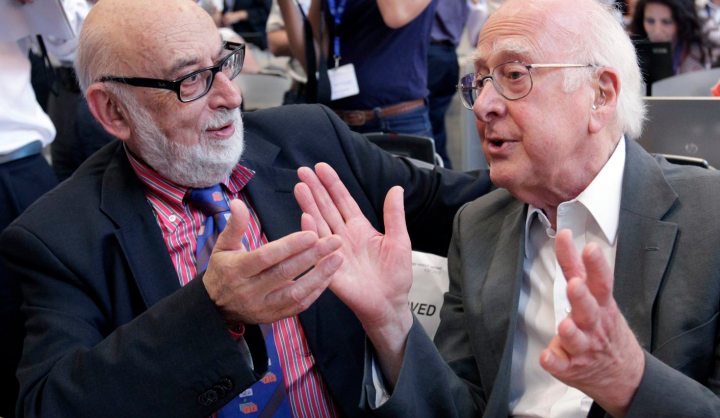Maverick Life
Boson’s up: Higgs and Englert win the Nobel Prize for physics

How is it possible that Peter Higgs and Francois Englert—the folks responsible for all the hubbub over the so-called, massively hyped God particle—hadn’t yet won the Nobel Prize? That mistake's been rectified now. By RICHARD POPLAK.
Peter Higgs and Francois Englert are old. They are, thanks to a successful testing of their signature theory at the Large Hadron Collider in CERN, Switzerland, more relevant than perhaps they have ever been. But they are old, and they come from another time. Higgs was born in 1929 in England, and was home-schooled during World War II. Englert, a Belgian Jew, dodged the Nazis in the same war, and was liberated by the US Army in Annevoie-Rouillon in 1945.
But time, as physics has long suggested, is bendable, fungible, malleable, erasable. So it is reasonably fitting that these two elderly gentlemen have finally been awarded the Nobel Prize for their explanations regarding the functioning of the universe. The Higgs boson, the cherry on top of their reams of collective theory is, in short (insofar as there is a “short”) the particle responsible for giving mass to other particles. Mass, in the Higgs boson sense of the term, is less avoirdupois than it is gravitational charge—the force that pulls one particle toward another, and makes up the physical universe. Hence, the much detested moniker “the God Particle”. (Higgs believes the term could be construed as offensive to religious folk. What a gent).
Like most discoveries in physics, there was no eureka moment, but a steady accretion of theory that culminated in a moment of collective discovery. The Higgs boson was less the Holy Grail Higgs, Englert and others were searching for, and rather the child of a more sweeping theory of how the universe operated at conception. Look at it this way: the moment the universe came into being, the particles within it were massless, and buzzed around at the speed of light. A trillionth of a second later, after a charged phenomenon called the Higgs field switched on, those particles acquired mass, slowed the heck down, and the job of building the physical universe began. The Higgs boson is the tiny particle that, in theory, makes up the Higgs field, and allows the universe its cohesiveness.
This work came on the back of other theories by previous Nobel winners, but their work, most notably that of Yoichiro Nambu, unfortunately left particles massless. That wouldn’t do. Three papers, written in turn by Robert Brout, Francois Englert, Gerald Guralnik, C.R. Hagen and Tom Kibble (Brout died in 2011; the latter three published their paper last, and have been very unfairly not included in the Nobel party), postulated something similar to the Higgs mechanism and the resulting Higgs boson. It was 1964—theoretical physics’ watershed, and the year that still might be credited for explaining how the universe operates.
Why give Higgs and Englert the Nobel Prize now? Well, up until recently, there was no way to properly test their theory. That changed when the Large Hadron Collider went online on 10 September 2008, at the Geneva-based CERN research facility. The LHC is one of the more incredible feats humankind has ever undertaken. Its only function is to shoot protons at each another through a massive 27km long circular pipe, and to measure the results of those collisions. In theory, those train smashes should result in tiny but measurable flashes of energy that produce quarks, electrons, light and—every now and again—the ever elusive Higgs particle. The Higgs is a reticent beast that refuses to hang about and have its picture taken, and degrades into constituent particles almost as soon as it is produced.
The LHC throws so many protons at so many protons that the data set produced ends up providing physicists with evidence conclusive enough to confirm the theory. Thousands of scientists combined data from trillions of colliding particles, and it all came together on 4 July 2012, with the official discovery of the Higgs boson—about one collision per trillion resulted in a Higgs. Thus ended one of modern science’s longest running manhunts. The finding was nothing short of momentous—one of the most important days in any of our lives. Higgs himself was astonished that his theory was born out within his lifetime.
The LHC is not your old high school’s science lab—the facility has cost over US$9 billion, and costs another small fortune to maintain. But we now live in a universe that has become a little more understandable, a little more readable. There can be no controversy over the awarding of the Nobel to Higgs and Englert. “I am overwhelmed to receive this award and thank the Royal Swedish Academy,” Higgs said in a statement released by the University of Edinburgh. “I hope this recognition of fundamental science will help raise awareness of the value of blue-sky research.”
We’ve figured out the universe. Now, we can just relax, take a load off, and try to muse on how two geriatric physicists will blow their shared $1.25 million prize. DM
Read more:
- Watch the Higgs-Boson explained at Vimeo
Photo: British physicist Peter Higgs (R) talks with Belgium physicist Francois Englert before a news conference update in the search for the Higgs boson at the European Organization for Nuclear Research (CERN) in Meyrin near Geneva July 4, 2012. REUTERS/Denis Balibouse















 Become an Insider
Become an Insider